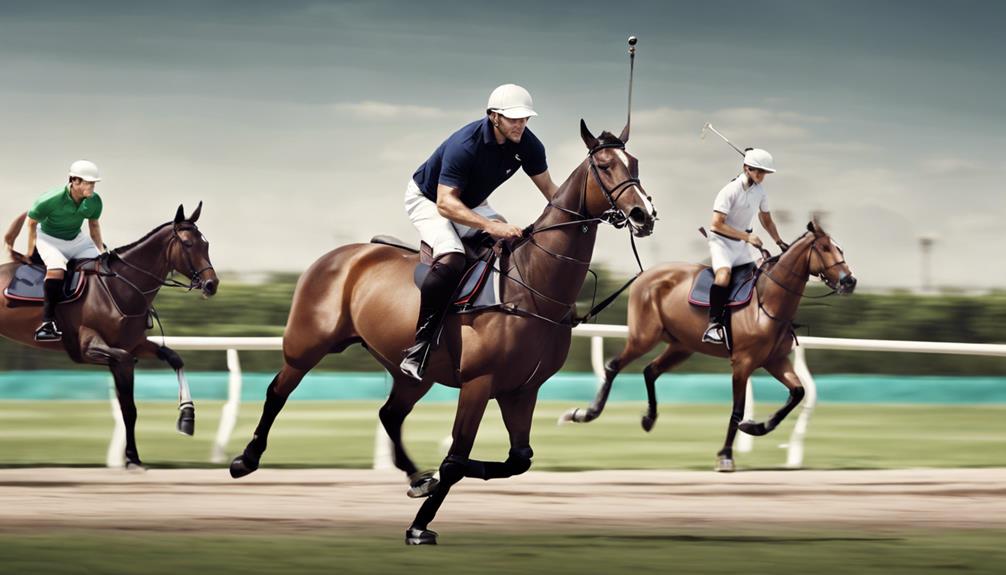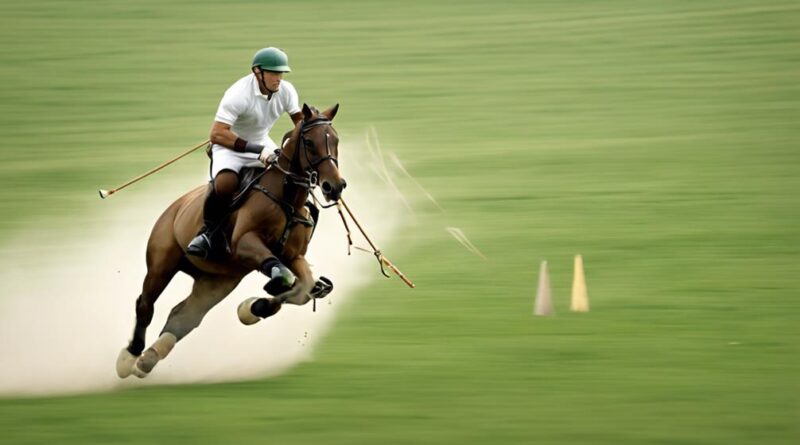What Techniques Are Effective for Training Polo Horses?
When it comes to training polo horses, it's like sculpting a masterpiece from raw clay. Each stroke and technique molds the horse into a skilled athlete on the polo field.
But what specific methods are truly effective in this intricate process? Let's explore the nuanced art of developing these majestic creatures into agile and responsive partners in the fast-paced world of polo.
Understanding Polo Horse Behavior
To effectively train polo horses, it's crucial to understand their behavior patterns and instincts. Polo horses are highly sensitive animals that respond well to clear communication and consistent training techniques. Behavior modification plays a significant role in shaping their responses, making it essential to establish a strong foundation based on trust and respect.
When working with polo horses, effective communication is key. Horses rely heavily on body language to convey messages, so it's vital to be aware of your own movements and gestures. By understanding how horses interpret signals, you can better communicate your intentions and establish a harmonious connection with your horse. Training techniques should focus on positive reinforcement and clear cues to reinforce desired behaviors.
Body language plays a crucial role in training polo horses. Horses are incredibly perceptive to subtle cues, so it's important to maintain a calm and assertive demeanor during training sessions. Avoiding sudden movements or aggressive gestures can help create a safe and comfortable environment for your horse to learn and grow. By observing your horse's body language in return, you can better understand their moods and adjust your training approach accordingly.
Building Trust and Bonding
When aiming to build trust and establish a strong bond with your polo horse, consistency in your interactions is key. By engaging in trust exercises and bonding activities, you can deepen your connection with your horse and enhance your training sessions.
Here are some effective ways to build trust and bonding with your polo horse:
- Groundwork: Spend time on the ground with your horse, practicing exercises that promote trust and communication. This could include desensitization activities, liberty work, or simply grooming and spending quality time together.
- Positive Reinforcement: Reward your horse for good behavior to reinforce trust and build a positive association with training. Using treats, praise, or scratches can create a bond based on mutual respect and understanding.
- Consistent Routine: Establish a consistent training schedule and stick to it. Horses thrive on routine, and knowing what to expect can help build trust and reduce anxiety.
- Body Language: Pay attention to your body language when interacting with your horse. Clear, calm, and confident body language can help establish trust and convey your intentions effectively.
Groundwork and Lunging Exercises
Establishing a strong foundation through groundwork and lunging exercises is crucial for developing your polo horse's physical fitness and responsiveness. Consistent routine, patience, and consistency are key when engaging in these training activities. Groundwork involves exercises such as leading, backing up, yielding hindquarters, and moving the shoulders. Lunging exercises help improve your horse's balance, flexibility, and obedience to voice commands. Incorporating obstacle course training during groundwork sessions can enhance your horse's agility and responsiveness to different cues.
Desensitization exercises are also essential during groundwork to accustom your horse to various stimuli like flags, tarps, or sounds, ensuring they remain calm and focused during polo matches. These exercises build trust and confidence between you and your horse, fostering a deeper bond.
When engaging in groundwork and lunging exercises, always prioritize safety by using proper equipment and working in a controlled environment. Remember to start slowly and gradually increase the difficulty of exercises as your horse becomes more proficient. By maintaining a consistent routine and showing patience and consistency in your training approach, you'll set your polo horse up for success in their future polo endeavors.
Introducing Polo Equipment Gradually
Gradually introduce polo equipment to your horse to ensure a smooth transition and optimal comfort during training sessions. It's essential to acclimate your horse to the gear slowly to prevent any discomfort or resistance during practice.
Here are some key points to consider for the gradual introduction and proper adjustment of equipment:
- Start with Basic Equipment: Begin by introducing your horse to basic gear such as a saddle pad and bridle before moving on to more complex equipment like the polo saddle and mallet.
- Monitor Comfort Levels: Pay close attention to your horse's reactions when introducing new equipment. Ensure that the fit is correct and make any necessary adjustments to enhance comfort.
- Progress Step by Step: Introduce one piece of equipment at a time to allow your horse to get used to the feel and weight before adding more gear to the ensemble.
- Regular Equipment Checks: Continuously assess the fit and condition of the equipment to ensure that it remains comfortable and secure for your horse. Make any adjustments as needed to accommodate your horse's size and movement.
Practice Riding and Ball Control
To enhance your polo horse's skills, focus on practicing riding techniques and refining ball control abilities. Improving balance is crucial for both you and your horse to maneuver effectively on the polo field. Work on maintaining a strong and centered position in the saddle to provide clear cues to your horse. Practice different riding exercises such as posting trot, two-point position, and lateral movements to enhance your stability and communication with your horse.
Refining technique is essential for precise ball control during a polo match. Spend time practicing hitting the ball at varying speeds and angles to improve your accuracy. Work on your mallet swing technique to ensure you can strike the ball cleanly and with power. Focus on coordinating your hand, eye, and body movements to connect with the ball effectively.
Additionally, practicing riding and ball control drills regularly will help you and your horse develop a strong partnership and understanding of each other's movements. By consistently working on these skills, you can build confidence in both yourself and your horse, leading to better performance on the polo field. Remember, patience and dedication to improving your balance and refining your technique will ultimately contribute to your success in polo.
Implementing Tactical Training Drills
Enhance your polo horse's strategic prowess by incorporating dynamic tactical training drills into your practice regimen. These drills focus on improving controlled agility and fostering strategic communication between you and your horse on the polo field.
Tactical Training Drills:
- Pattern Recognition: Create drills that involve navigating specific patterns on the field to enhance your horse's agility and responsiveness to your cues.
- Team Coordination: Practice drills that simulate game scenarios, focusing on coordinated movements with your teammates to improve strategic communication during matches.
- Obstacle Courses: Set up obstacle courses that require quick thinking and precise movements to develop controlled agility and adaptability in different situations.
- Mock Matches: Organize mock matches during training sessions to apply tactical strategies in a realistic setting, improving decision-making skills under pressure.
Conditioning and Fitness Regimen

Developing a comprehensive conditioning and fitness regimen is essential for maximizing your polo horse's performance on the field. To ensure your horse is in prime physical condition, incorporating strength training and interval work into their routine is crucial.
Strength training plays a vital role in enhancing your polo horse's muscle power and endurance. Exercises such as hill work, trotting over poles, and controlled galloping can help build the necessary muscle strength for quick sprints and sudden stops during a polo match. By gradually increasing the intensity of these exercises, you can steadily improve your horse's overall strength and agility.
Interval work is another key component of a successful conditioning program for polo horses. This type of training involves alternating between periods of high-intensity exercise and rest, mimicking the stop-and-go nature of polo gameplay. Incorporating intervals into your horse's workout routine can improve their cardiovascular fitness, allowing them to recover quickly between bursts of activity on the field.
Continuous Positive Reinforcement
Incorporate consistent positive reinforcement techniques to encourage and reward desired behaviors in your polo horse. Reward-based training is a powerful method that helps your horse understand what you expect from them and motivates them to repeat those behaviors. By providing consistent feedback through positive reinforcement, you create a clear line of communication with your horse, which can lead to faster and more effective learning.
Tips for Implementing Continuous Positive Reinforcement:
- Use treats: Providing treats as a reward for desired behaviors can be highly effective in reinforcing positive actions.
- Praise and petting: Verbal praise and physical affection can also serve as powerful rewards for your polo horse.
- Consistency is key: Make sure to reward the behavior you want every time it occurs to reinforce the desired action.
- Timing is crucial: Offer the reward immediately after the desired behavior to ensure your horse associates the treat or praise with the correct action.
Frequently Asked Questions
How Can a Polo Player Effectively Communicate With Their Horse During a Match?
During a match, effective communication with your horse in polo is crucial. Use your body language, reins, and voice commands to guide your horse smoothly.
Develop a strong bond through consistent training techniques, building trust and understanding. Practice clear and concise signals to convey your intentions during the game.
Pay attention to your horse's responses and adjust your communication accordingly. By honing your communication skills, you can improve player-horse dynamics and enhance match strategies.
What Are Some Common Mistakes to Avoid When Training a Polo Horse?
When training a polo horse, it is important to avoid common pitfalls like rushing the process and neglecting proper conditioning.
Take your time to build a strong foundation and gradually introduce new skills. Ensure your horse is physically fit and mentally prepared for the demands of polo.
Are There Specific Dietary Requirements for Polo Horses to Maintain Their Performance Levels?
To keep your polo horses performing at their best, it's crucial to maintain specific dietary requirements. Feeding schedules play a vital role, ensuring they get the right nutrients at the right times. Supplements can also help meet their nutritional needs.
Establishing proper exercise routines and ensuring adequate hydration are key components to support your horses' performance levels. By paying attention to these aspects, you can help your polo horses excel on the field.
How Often Should a Polo Horse Receive Veterinary Check-Ups and Care?
For your polo horse's well-being, it's crucial to schedule regular check-ups with the vet. These visits help in monitoring your horse's health and catching any issues early on.
Preventive measures like vaccinations and dental care can also be discussed during these appointments.
What Are Some Key Signs That Indicate a Polo Horse May Be Experiencing Stress or Burnout?
Recognizing signs of stress in polo horses is crucial for their well-being. Watch for changes in behavior like restlessness, decreased appetite, or excessive sweating.
Managing stress involves providing proper rest, balanced training, and a comfortable environment. Pay attention to your horse's cues and adjust training routines accordingly to prevent burnout.
Regular veterinary check-ups can also help identify any underlying issues contributing to stress. Keep communication open with your equine health team to ensure your horse's welfare.
Conclusion
In conclusion, effective training techniques for polo horses involve understanding their behavior, building trust through bonding, introducing equipment gradually, practicing riding and ball control, implementing tactical drills, maintaining a conditioning regimen, and providing continuous positive reinforcement.
By following these steps, you can develop a strong partnership with your polo horse and enhance their performance on the field. Keep up the hard work and dedication to ensure success in your polo training endeavors.
